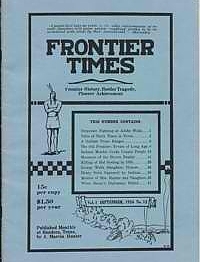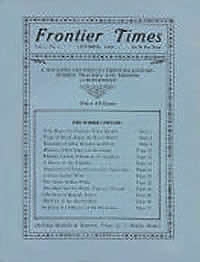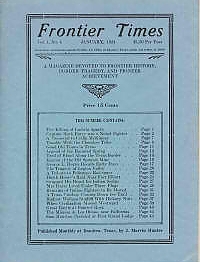By using our website, you agree to the use of cookies as described in our Cookie Policy
Magazines & Instant Downloads
Vol 01 No. 12 - September 1924
Desperate Fighting at Adobe Walls
What is known as the Adobe Walls fight on the Canadian River in Hutchinson County, 1874, probably stands pre-eminent above all other Indian fights that have occurred in Western Texas. It, is the story of 28 men successfully repulsing the repeated desperate attacks of more than five hundred, well armed Indians, superstitious, fanatical, made desperate by the white man's aggressions, and confident of victory by the sorcery of their medicine men. A great many romantic accounts of this fight have been written, all of them conflicting one with another, and perhaps none of them correct. The following account was obtained from one of the participants, and has been pronounced correct by another man who participated in the memorable affair, and may therefore be accepted as authentic:
Further Mentions: Kit Carson at one time had a trading post there, In 1874 Charlie Rath, Charley Meyers, and perhaps, one or two others who had been running buffalo hunters' supply establishments in Dodge City, Kan., went to Adobe Walls and established branch concerns, the buffalo hunters, being very plentiful in that vicinity., J. J. Clinton, a character by the name of Antelope Jack, Billy Dixon and Arthur Forest, Billie Tyler and the two. Shadley brothers, General Miles, Mrs. Olds, Bat Masterson, Tobe Robinson, Arthur Forrest, two Shadley brothers, Charley Aleyers, Fred Meyers, Bill Langdon, Charley O'Keefe, Charley Rath, Joe Langdon, Billie Dixon., Fred Leonard, Jim Hanrahan, Mike McCabe, Lem Wilson, "Whiskey" Smith, John Clinton, Henry Seay, Mrs. Olds, Henry Wertz, Moccasin Jim, George Burr.
Thrilling Tales of Early Times in Texas
By Taylor Thompson.
Describes the celebration of "pastores," Christmas festivities usually began in the Mexican part of the town of San Antonio west of the San Pedro, about two weeks before Christmas, and lasted till daylight Dec. 26. On one particular occasion, the event was interrupted by an onslaught of hostile Indians, and the fight engaged with Rangers.
Captain Wright, a Gallant Texas Ranger
By J. Will Filvella
One of the most fearless of the Texas Rangers was Captain Will L. Wright, commanding Company B, Texas Rangers, who made his headquarters at Weslaco, Texas, near the Rio Grande, but who, with his company of a sergeant and ten men, "covered" the entire border country of Texas from Point Isabel and 'Brownsville to Laredo and Eagle Pass, a border front over 300 miles in length, in addition to scouting work done far inland. Captain Wright was born in Yorktown, DeWitt County, and was reared and educated in that part of Texas. He was elected sheriff of Wilson, County in 1902 and served in that capacity fifteen years. This is his story. Further Mentions: Refugio Jarouez, Capt. J.H. Rogers, J. R. Davenport, the old P. & J. saloon in Cotulla, Company B of Texas Rangers, Adjutant General Harley., Colorado Chiquita, in Zapata County, Bruni, in Webb County, Bernaina ranch in Duval County, Charles H. Wright
The Old Frontier; Events of Long Ago
W. K. Baylor.
Life story of John Robert Baylor, born in Bourbon County, Kentucky, on the 20th day Of July, 1822, and died in Uvalde County, Texas, in 1895. Baylor lived first in Payette county for nearly two years and then relocated to Marshall, where he married, and in 1844, came back to Fayette county and settled near Fayetteville, where he started a farm and cattle ranch and where he was active in all matters of public interest, waged a relentless warfare on all disreputable characters and was generally elected to command any expedition against outlaws, hence his title, Captain Baylor. The story refers to the Council-House fight, The abduction of Mrs Watts. Also mentions an event where Baylor took nearly ail the Reservation Comanche Indians on a buffalo hunt, and was betrayed by them, and they killed his interpreter, he with his family moved some eighteen miles further down the Clear Fork and established among the first, if not the first cattle ranch in Stephens county. Accounts various desperate Indian raids.
Further Mentions: Col. John H. Moore, The Council-House fight which took place on the 19th day of March, 1840. On August 6th following, the Comanches attacked Victoria, On the 8th they attacked Linnville on the coast. A Mrs. Watts was carried into captivity, The Battle of Plum Creek, Camp Cooper, on the Clear Fork of the Brazos River., a man by the name of Gentry, who lived in Grayson county, the Indians on the Camp Cooper reservation, Mr. Ross and a Mr. Cassiday. Hubbards Creek, Virgel Wooley, Belton by name, William Holden who lived on the Clear Fork, Mr. Lambshead. Who was brutally killed and scalped, a Comanche chief whose name was Pine-O-Chamma, Parson Tackitt, Fort Cobb., In 1858, in. the spring, Captain Wm. Preston, John Damson, Tom Stockton, and others had quite a battle with some reservation Comanches on Hubbard's Creek, Captain J. R. Bay, the Mullens were prominent from Bosque and Erath counties, Barry and Cureton were prominent names, Mr. Barclay., A Mrs. Cornett
Indians Murder Cooke County People
W. S. Adair. Mrs. Sarah Witt McCutcheon., whose son is W. R. Sheegog, of Dallas, gives first-hand account of the Indian raid in Cook County in January, 1868. This is a very sad account, but reveals the dauntless courage of the early settlers, and gives some good early Cooke county history and genealogy as well.
Further Mentions: brother Hardin, Mrs. Edward Sheegog, my sister-in law, who lived three miles from us, was a prisoner in the hands of the Indians, her father, Joe Manasco, living seventeen miles west of Gainesville, May and Lizzie Manasco, 8 and 10 years old, the dwelling of Samuel Doss, the big cattleman, near Gainesville. Mrs, A. W. Waller, Among the prisoners was a Miss Carrollton 16 years old, Dr. Davidson, nine persons were murdered on this raid. They were Mr. Leatherwood, Mr. and Mrs. Torn Fitzgerald, Arthur Parkhill, Mr. Loney, Mrs. Carrollton, Joseph Manasco, and May and Lizzie Manasco, with the negro boy missing or unaccounted for, Preston Witt, Whitesboro, Dr. B. S. Shelburne of Lebanon, Collin County, Mrs. W. A. Smith, Hamp Witt who bought 2,400 acres of land near the present town of Muenster
Indian Massacre Of The Brown Family
T. U. Taylor. Relates the first-hand account of Joseph Shotwell Brown, concerning this very sad piece of Parker County history. At the time of the murder the family consisted of father and mother, Mr. and Mrs. F. C. Brown, seven girls, Sarah aged sixteen, Martha aged fourteen, Jane aged twelve, Bettie aged ten, Moie eight years old, and Essie and Tennie who were twins in arms:. Joseph Shotwell, four years of age was the only boy. The family had come from Maury County, Tennessee, with a party of emigrants, to Collin County, Texas, then to Palo Pinto County, but finally located in Parker County, eight or ten miles from Weatherford on Patrick's Creek. The nearest neighbors, the Gatlin family, lived about three hundred yards away, while it was half a mile to the home of Ike Welch. Mr Brown was serving the Confederacy at the time, but when he received the news about the brutal attack upon his family, he defied orders and returned to the scene where he found…
Further Mentions: the Sam Houston Normal College, President, Harry F. Estill, F. C. Brown, Mr. Catlin, Gen. Bankhead, the killing of William and Stuart Hamilton, sons of Reverend John Hamilton of the Christian Church, whom they had killed on the morning of the same day on Patrick's Creek, Mr. Dallas Thommasson, Jane married Newt Pickard, Bettie married a Mr. Gillespie in Fayette county, Mr. Will Phillip of Fayette county, Texas.
Old Rangers in, Reunion.
As we go to press with this issue of Frontier Times, the big reunion of the Texas Ex-Rangers Association is in progress at Menard. Many of' the 'old boys who fought the Indians and followed the bloody trail of outlaws and desperadoes in the early days will be there to once more greet their comrades of the frontier. Captain Dan W. Roberts, Major Green, Captain J. B. Gillett, and other noted rangers, of the gallant old type will be in attendance.
The Killing of Hal Gosling in 1885
Ernest Beseler.
This is an amazing account of a love triangle that resulted in the bloody murder of Marshal Gosling and the slaying of others involved. Contains some interesting Bexar, Kendall and Gillespie county history. Also some insightful information into the stage system of mail delivery in the area and the dangers that highwaymen imposed. Someone ought to make a movie about this one!
Further Mentions: Stage routes along the "Big Hill," about sixteen miles south of Fredericksburg and at Balcones Creek, about five miles south of Boerne., the school house at Balcones Creek, Frank Scott, Yeager and Brannon, the Drown and Scott place, Balcones School, Old Mrs. Drown, who was related to Pitts
Early Days in Texas.
W. M. McKee, of Bowie, Texas. Short, but interesting sketch of early days to the Dallas. "In reconstruction days in Texas promisory notes were payable in gold. Farm hands were paid $10 a month or 75c a day "from sunup to sundown." Wheat was 50c a bushel, corn usually 25c, but some years $2.25 a bushel. . Fat beef cows on foot were $12.50, beef hides $1.50, work oxen $40 a yoke, horses $20. Good saddle horses were $25... We hauled our cotton, wool and beef hides to Jefferson, Texas, sold them for gold and brought back the gold -thousands of dollars -in ox wagons. Sometimes we had ten to twelve wagons in a "train". We were never held up nor robbed. Old timers seldom put up their hands.
I remember a story of an early settler who wrote back to his brother to come to "God's country." He came and the two brothers saddled up two Texas ponies, mounted them and rode all day over .the range. As far as the newcomer could see the... We went to school in log houses, No wonder we were great men. No public schools then' McGuffey's Readers cost 60c, Smith's, Arithmetic the same, and the old Webster blueback spelling book 25c". , Union Stock Yards, San Antonio, Texas. Brief Account Of Death Of "Court" Babb" Mentions: his home at Stop 10 on the Fort Worth-Dallas highway, John Babb, Wise County pioneer, lived with his wife and four children on a little ranch twelve miles west of Decatur. A Mrs. Roberts, who lived with them at the ranch, T. A. Babb of Amarillo, a war party of Indians appeared, Mrs. Babb's throat was cut and her infant was left lying unharmed in her blood. Mrs Roberts and the two younger children were carried off into captivity, from which they were ransomed a year later. W. T. (Tom) Waggoner, Mrs. J. D. Bell of Greenville, and Miss Margie Babb of Fort Worth.
George Webb Slaughter was a Pioneer.
Includes old photos of he and his Mrs. Slaughter. Mega-Cattleman, Baptist minister, patriot, soldier, physician and pioneer, George Webb Slaughter was a native of' Lawrence county, Mississippi, his birth occurring May 10, 1811. William Slaughter, his father was a Virginian, born in 1781, his death occurring in Sabine county, Texas in 1852. The elder Mr. Slaughter was a farmer and had seen service in the war of 1812, fighting with Jackson at New Orleans. He married Miss Nancy Moore, of South Carolina, and was the father of eight children, four of them boys. In 1821 the family moved to Copiah county, Mississippi, and flour years later started to Texas, but stopped for a time in Louisiana, and it is while living in the latter state that George Webb Slaughter received the only schooling which he ever had opportunity to obtain. In 1830, the Slaughter family crossed the Sabine and settled in the area. This is his great and notable story.
Further Mentions: Col. Piedras, Col. Bean Andrews, Col. Travis, Mrs. Dickinson, Miss Sarah Mason, General Rusk, Chief Bowles, Captain Todd, In 1852 he moved to Freestone county, intending to turn his attention to stock-raising. He brought with him ninety-two head of cattle and established a ranch near the old town of Butler, and in five years he resided there his herd increased to 600 head. Mr. Slaughter believed there were better opportunities to be gained by removal further west, and in 1857 drove his herds to Palo Pinto county, locating five miles north of the town of that name, at that time known as Golconda. He bought 2,000 acres of land and located by certificate 960 acres more, and the ranch located at that time was thereafter his home., Young county, at a point near the Ross Indian, Reservation., Slaughter disposed of 12,000 head of cattle to James Loving and Charles Rivers. Story mentions income received from sale of cattle 1868-1873. Property in Mineral Wells. Dry Creek, near Graham, Sand Creek.
Henry Scott Captured By Indians
J. R. Lott, Poteet, Texas. Among the early settlers of the coast section of Texas were quite a number of Irish people who came over from the old country with the Powers and Hewitson Colony, the settlement of which extended from the San Antonio River to San Patricio on the Nueces River. The Scott family of this colony concluded to locate near Brownsville on what was then known as Resaca de la Palma, about five miles from Brownsville. They had been living there undisturbed for sometime, when one bright Sunday morning they found themselves completely surrounded by twenty or thirty Indians, who furiously attacked them. The father and eldest son were both slain before they could make any defense. Another son, Henry Scott, and a Mexican boy about fifteen years old were captured, while the mother and one child succeeded in hiding themselves among the rank weeds and escaped being seen by the Indians. After taking everything they could conveniently carry away, one of the Indians asked the boy in Spanish where their horses could be found, threatening the boys with death if they did not promptly reveal the whereabouts of the horses. The Mexican boy pointed in a direction he thought some horses would be found, and they started out to get them, taking the boys along. When they reached a small glade where they expected the horses to be grazing not a horse was to be seen, and the Indians began preparations to carry out their threat. Just at that moment, however, the horses were seen coming into the glade. The Indians sent out flankers on each side and soon had the animals inside a corral of living Comanches. Each of the Indians had two lariats and buckskin strings, and after securing a mount for each, the boys included, they tied the captives' hands so tight as to almost stop circulation of blood, then made them mount on the bareback of the horse, and tied a rawhide tug above their ankles and passing it under the horse, tied it securely to the other ankle and so tight as to cause terrible pain. The wretches then took a northwest course and hurried out of the country. Henry Scott suffered so much he cried aloud from pain, and his agony seemed to delight the Indians, who would mimic him and make faces at him, but the little Mexican boy was game and put in good time cursing and abusing the redskins, calling them squaws and coyotes. They traveled rapidly all day and part of the night, finally reaching a lake of water where they went into camp. The, boys were untied from the horses and told to lay down to sleep, and the Indians formed a circle around them, leaving two Indians on guard. The boys were so exhausted they could sleep but little. Early the next morning they were off again, but the Indians did not tie their limbs so tight this time, and their suffering was not so great. After traveling all day they stopped just before night at a water hole and camped, killing a colt to roast. After gorging themselves, they again formed a circle about their captives and lay down to sleep, with the boys in the center. Soon all were sound asleep. The Mexican warned Henry to keep awake and they would escape, constantly pinching him to keep him from dosing. Finally the regular breathing of the slumbering Indians indicated that, their sleep was heavy, and the two boys silently arose and stepping carefully over the Indians nearest them they crept into the thicket and untied two of the best horses in the outfit. Henry mounted his horse and was anxious to be off, but the little Mexican whispered to him that the Indians had but one gun and he was going back to get it. Handing his rope to Henry he softly stole back to the camp and stealthily lifted the gun from the hands of the sleeping warrior, and..."
Murder of Mrs. Hunter and Daughter
This is excellent, very early history of Warren and that area of Grayson county. The story is set against the almost ceaseless assaults of savage Indians that occurred relentlessly during that early period. This particular account depicts the sad tale of Doctor Hunter and his family who experienced brutal treatment and the murder of his wife and daughter. The family consisted of Doctor Hunter, his wife and four children, one son and daughter grown, and two little girls of ten and twelve years of age.
Late in, the afternoon the two little girls took a bucket and went to the spring, a hundred yards or more from the house, to get some water. Little realizing the dreadful doom awaiting them at the end of their path, they tripped along in unsuspecting innocence, and with merry thoughts and childish chatter, reaching the spring, filled the bucket and started back to the house. But glittering restless eyes were watching every movement and they had taken but a few steps when a hideously painted Indian sprang out of the bushes by the path, and before a sound could be uttered he shot the younger girl with an arrow, killing her instantly. This painted fiend was joined by another and still another until ten of his companions appeared from where they had been concealed in the bushes, and the poor girl, paralyzed with fright, offered no…
Further Mentions: the marriage of their eldest daughter to Mr. William Lankford. of Warren, etc.
When Henry Shane's Diplomacy Failed
Brief story of Henry Shane, of Uvalde county, one of the bravest and most daring Indian fighters, who while employed on the ranch of Major Riordan, near Fort Clark, was captured and effected a daring escape, living to gain notoriety as a great fighter.
__________________________________________________________________
Some Names in this volume:
W. S. Adair; Joe Airhart; Mary Ann Airhart; Col Bean Andrews ; "Bank" Babb; Casibianca Babb; "Court" Babb; "Dot" Babb; H. C. (Court) Babb; John Babb; Maggie Babb; Margie Babb; T. A. Babb; Gen Bankhead; Sebe Barrymore; Bass; Capt Baylor; ; Capt J. R. Baylor; Dr John Baylor; Capt John R. Baylor; John Robert Baylor; John Roy Baylor; W. K. Baylor; Col W. K. Baylor; Col H. G. Bedford; Mrs J. D. Bell; Ernest Beseler; Steve Birchfield; Wm P. Birchfield; Chief Bowels; Bowles; Bettie Brown; Betty Brown; Essie Brown; F. C. Brown; Mrs F. C. Brown; Henry J. Brown; Jane Brown; Joe Brown; Joseph Shotwell Brown; Martha Brown; Moie Brown; Sarah Brown; Tennie Brown; George Burr; Frank Caldwell; Miss Carrollton; Kit Carson; J. J. Clinton; John Clinton; Geo F. Cram; J. R. Davenport; Dr Davidson; John Dawson; Billie Dixon; Billy Dixon; Samuel Doss; Sargant P. Elkins; Mary Jane Ely; Harry F. Estill; J. Will Falvella; Col Fannin; Arthur Forest; Arthur Forrest; Bettie Gillespie; Frank Gillespie; Joe Gillespie; Gillett; Hal Gosling; ; Maj Green; Rev John Hamilton; Stuart Hamilton; William Hamilton; Jim Hanrahan; John Wes Hardin; Gen Harley; William Holden; Gen Houston; Refugio Jarquez; E. P. Lamborn; Bill Langdon; Joe Langdon; William Lankford; Layton; Mrs M. J. Lee; Fred Leonard; J. R. Lott; James Loving; Joe Manasco; Joseph Manasco; Lizzie Manasco; May Manasco; Charles L. Martin; Sarah Mason; Bat Masterson; ; Mike McCabe; Sarah Witt McCutcheon; W. M. McKee; Charley Meyers; Fred Meyers; Gen Miles; Col John H. Moore; Nancy Moore; Charley O'Keefe; Arthur Parkhill; Tennie Phillip; Will Phillip; Jane Pickard; Newt Pickard; Col Piedras; Capt William Preston; Charley Rath; Charlie Rath; Dudley T. Richardson; George Richardson; Maj Riordan; Charles Rivers; Capt Dan W. Roberts; Tobe Robinson; Capt J. H. Rogers; Gen Rusk; Saunders; ; Frank Scott; Henry Scott; Henry Seay; Henry Shane; Edward Sheegog; Mrs Edward Sheegog; W. R. Sheegog; Dr B. S. Shelburne; C. C. Slaughter; George Webb; John Webb; William Webb; G. P. Smith; Mrs W. A Smith.; "Whiskey Smith "; Tom Stockton; Parson Tackitt; T. U. Taylor; Dallas Thommasson; Martha Thommasson; Thompson; Taylor; Capt Todd; Billie Tyler; W. T. Waggoner; Mrs A. W. Walker; Ike Welch; Henry Wertz; Lem Wilson; Rev Eli Witt; Hamp Witt; Jack F. Witt; John T. Witt; Preston Witt; Virgel Wooley; Capt Wright; Charles H. Wright; Lt Wright; Capt Will L. Wright; Will L. Jr Wright; Wrenn.
$4.95
‹ Back








